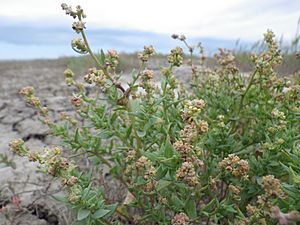Stutzia facts for kids
Quick facts for kids Stutzia |
|
|---|---|
 |
|
| Stutzia dioica | |
| Scientific classification | |
| Kingdom: | |
| (unranked): | |
| (unranked): | |
| (unranked): | |
| Order: | |
| Family: | |
| Subfamily: | |
| Tribe: |
Atripliceae
|
| Genus: |
Stutzia
E. H. Zacharias
|
| Synonyms | |
|
|
Stutzia is a group of plants, also known as a genus, that belongs to the Amaranthaceae family. This family includes plants like amaranth and quinoa. The Stutzia genus was officially named in 2010. Before that, it had a different name, Endolepis, which wasn't allowed anymore.
There are two known types, or species, of Stutzia plants. These plants are found in the western parts of North America. Sometimes, they were even considered part of another plant group called Atriplex.
Contents
What Does Stutzia Look Like?
Stutzia plants are annual herbs, which means they complete their whole life cycle in one year. They usually grow between 3 and 50 centimeters tall and wide. They can stand up straight or spread out along the ground.
When they are young, the plants might have a light, powdery coating. As they get older, this coating often disappears. Their stems branch out from near the bottom, and older stems can have whitish bark.
Leaves and Flowers
Stutzia plants have many green leaves that grow one after another along the stem. Some leaves have small stalks, while others don't. The leaves are a bit succulent, meaning they are thick and fleshy, like a cactus or aloe vera plant. This helps them store water.
The leaves can be different shapes, like triangles, ovals, or long and narrow. Their edges are usually smooth.
These plants are monoecious, which means they have both male and female flowers on the same plant. The flowers grow in clusters at the tips of the stems or in the leaf corners.
Male flowers have five small, triangular parts called perianth lobes and five stamens, which are the parts that produce pollen. Female flowers are protected by two special leaf-like structures called bracteoles. They have a very thin perianth and an ovary with two stigmas for receiving pollen.
Fruits and Seeds
After the flowers are pollinated, the bracteoles around the female flower grow larger. They can become 2 to 20 millimeters long and enclose the developing fruit. The fruit itself is small and oval-shaped, and it stays attached to the seed.
Inside the fruit is a single seed. The seed has a thin, brown or reddish-brown outer layer. The plant usually flowers from April to July.
Scientists have also studied the chromosomes of Stutzia. They found that these plants have 9 chromosomes in their reproductive cells (haploid) and 18 chromosomes in their body cells (diploid).
Where Does Stutzia Grow?
Stutzia plants are found across western North America. You can see them in places like Alberta and Saskatchewan in Canada, and in many U.S. states. These states include California, Colorado, Montana, Nevada, North Dakota, South Dakota, and Wyoming. They might also grow in Oregon.
These plants prefer dry places with alkaline or salty soil. They can grow at elevations from about 400 to 2,200 meters (about 1,300 to 7,200 feet).
Stutzia dioica is the more common of the two species. It often grows in salty or alkaline soils in areas known as badlands. You might find it growing alongside other plants like Atriplex species, sagebrush, or different types of grasses. Stutzia covillei also likes salty soils and can be found in areas with saltbush, greasewood, and rabbitbrush plants.
How Stutzia Was Named
The genus Stutzia was first officially described in 2010 by a botanist named Elizabeth H. Zacharias. She published her findings in a scientific journal. The name Stutzia was chosen to honor another botanist, Howard C. Stutz, who had done important work on these plants earlier.
Before 2010, this group of plants was known by the name Endolepis. However, this name was already used for a fossil plant from 1846, so it couldn't be used again for a living plant. That's why a new name, Stutzia, was needed.
Stutzia belongs to a larger group of plants called the Atripliceae tribe. This tribe is part of the Chenopodioideae subfamily, which is then part of the Amaranthaceae family.
Types of Stutzia Plants
There are two main species (types) within the Stutzia genus:
- Stutzia covillei (Standl.) E. H. Zacharias - This plant is also known as Coville’s orach.
- Stutzia dioica (Nutt.) E. H. Zacharias - This plant is often called Suckley’s orach.
Images for kids
See also
 In Spanish: Atriplex para niños
In Spanish: Atriplex para niños


